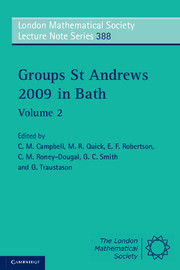Book contents
- Frontmatter
- Contents
- Introduction
- Algorithms for matrix groups
- Residual properties of 1-relator groups
- Words and groups
- The modular isomorphism problem for the groups of order 512
- Recent progress in the symmetric generation of groups
- Discriminating groups: a comprehensive overview
- Extending the Kegel Wielandt theorem through π-decomposable groups
- On the prime graph of a finite group
- Applications of Lie rings with finite cyclic grading
- Pronormal subgroups and transitivity of some subgroup properties
- On Engel and positive laws
- Maximal subgroups of odd index in finite groups with simple classical socle
- Some classic and nearly classic problems on varieties of groups
- Generalizations of the Sylow theorem
- Engel groups
- Lie methods in Engel groups
- On the degree of commutativity of p-groups of maximal class
- Class preserving automorphisms of finite p-groups: a survey
- Symmetric colorings of finite groups
- References
Recent progress in the symmetric generation of groups
Published online by Cambridge University Press: 05 July 2011
- Frontmatter
- Contents
- Introduction
- Algorithms for matrix groups
- Residual properties of 1-relator groups
- Words and groups
- The modular isomorphism problem for the groups of order 512
- Recent progress in the symmetric generation of groups
- Discriminating groups: a comprehensive overview
- Extending the Kegel Wielandt theorem through π-decomposable groups
- On the prime graph of a finite group
- Applications of Lie rings with finite cyclic grading
- Pronormal subgroups and transitivity of some subgroup properties
- On Engel and positive laws
- Maximal subgroups of odd index in finite groups with simple classical socle
- Some classic and nearly classic problems on varieties of groups
- Generalizations of the Sylow theorem
- Engel groups
- Lie methods in Engel groups
- On the degree of commutativity of p-groups of maximal class
- Class preserving automorphisms of finite p-groups: a survey
- Symmetric colorings of finite groups
- References
Summary
Abstract
Many groups possess highly symmetric generating sets that are naturally endowed with an underlying combinatorial structure. Such generating sets can prove to be extremely useful both theoretically in providing new existence proofs for groups and practically by providing succinct means of representing group elements. We give a survey of results obtained in the study of these symmetric generating sets. In keeping with earlier surveys on this matter, we emphasize the sporadic simple groups.
Introduction
This article is concerned with groups that are generated by highly symmetric subsets of their elements: that is to say by subsets of elements whose set normalizer within the group they generate acts on them by conjugation in a highly symmetric manner. Rather than investigate the behaviour of known groups we turn this procedure around and ask what groups can be generated by a set of elements that possesses a certain assigned set of symmetries. This enables constructions by hand of a number of interesting groups, including many of the sporadic simple groups. Much of the emphasis of the research project to date has been concerned with using these techniques to construct sporadic simple groups, and this article will emphasize this important special case. Recent work of the author and Müller has been concerned with Coxeter groups, so we shall describe this case too.
This article is intended as an ‘update’ to the earlier survey article of Curtis [14]. Since [14] appeared several of the larger sporadic groups have succumbed to these techniques and a much wider class of reflections groups have been found to admit symmetric presentations corresponding to symmetric generating sets.
- Type
- Chapter
- Information
- Groups St Andrews 2009 in Bath , pp. 384 - 394Publisher: Cambridge University PressPrint publication year: 2011
References
- 1
- Cited by

